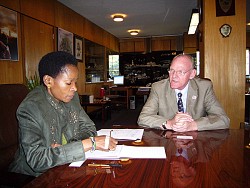21st UN-Habitat Governing Council
FIG strengthens its role in co-operation with the UN-Habitat
on tenure issues
Nairobi, Kenya, 13-20 April 2007
 |
Mrs. Anna Tibaijuka and President
Stig
Enemark in discussion on future co-operation between FIG and
UN-Habitat and the joint seminar in Stockholm in June 2008. |
Prof. Stig Enemark, President of FIG and the FIG Director attended
the 21st Session of the Governing Council of the United Nations Human
Settlements Programme UN-Habitat in Nairobi 16-20 April 2007. The Governing
Council meeting was preceded by the Business Partnership for Sustainable
Urbanisation stakeholders meeting that UN-Habitat Organised for the first
time for the private sector partners. FIG was invited to attend this meeting
on behalf of the Habitat Professionals Forum. During the week the FIG
representatives attended several meetings and sessions organised by the
Habitat Professionals Forum and the Global Land Tool Network. They also had
several bilateral meetings with the leaders of UN-Habitat and other
partners. President Enemark visited also the University of Nairobi and the
Institution of Surveyors of Kenya (ISK).
The 21st Session of the Governing Council was attended by more than 900
delegates from 92 countries and joined by 231 representatives of NGOs and 61
representatives of local governments and their associations. The five-day
meeting included representatives of other UN bodies, international financial
institutions, professional associations, women and youth groups, and the
private sector. Mrs. Anna Tibaijuka, Executive Director of UN-Habitat
said in her final statement that the Governing Council reaffirmed fresh
support for the agency after passing 10 resolutions aimed at taking the
battle against urban poverty closer to slum dwellers than ever before. The
governments passed two landmark resolutions. One gives the agency the
go-ahead to set up experimental financial mechanisms for pro-poor housing
and infrastructure, and the other is a new Medium-term Strategic and
Institutional Plan. Mrs. Tibaijuka said in a closing speech on the financial
resolution, that it would provide the means for the agency to strengthen its
role as a pre-investment catalyst, for bringing local initiatives in
pro-poor housing and infrastructure to scale. Other resolutions included new
guidelines on Decentralisation and strengthening of local authorities,
Guiding principles for providing basic services, a resolution on Arctic
cities, Urban youth development, and the approval of the biennial work
programme. The Governing Council meets every two years to set the agency’s
work programme and budget.
The work of the Governing Council was divided in administrative meetings
(plenary sessions and drafting committees), dialogues with the partners and
parallel events. The number of parallel events was this time smaller than
normally as one full day was designated for dialogues. Stig Enemark made a
speech at the roundtable on pro-poor land management for sustainable
urbanization that was part of the Global Land Tool Network activities. FIG's
contribution to GLTN is in the very focus of the Council work plan for the
next four years and will result in different projects in near future.
President Enemark also attended the Advisory Board of the GLTN that followed
the Governing Council.
Other meetings during the week included the meeting of the Habitat
Professionals Forum. At this meeting the role of the HPF was discussed and
support to developing it to the main partner representing all professionals
was received from Mrs. Tibaijuka and Mrs. Inga Klevby, Deputy
Executive Director of UN-Habitat. It was also agreed that the HPF will
organise a Roundtable at the 4th World Urban Forum in Nanjing, China in
September 2008. Stig Enemark was elected as the Chair of the HPF for the
next two years. The new focal point in UN-Habitat for the HPF is Dr. Christine Auclair.
At the meeting with Mrs. Tibaijuka the close links between UN-Habitat and
FIG were reconfirmed and Mrs. Tibaijuka confirmed the UN-Habitat committment
and her own participation to the FIG Working Week and the Joint
UN-Habitat/FIG Seminar on Slum upgrading and innovative finance mechanisms
in Stockholm in June 2008.
|

